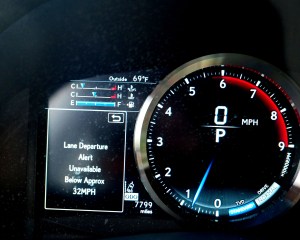It’s unfair to critique anything outside its purpose. You can’t judge a poem using essay criteria; you can’t pit the latest album from Leonard Cohen against Beyoncé. So you have to ask, even in reviewing a car, what its purpose is and does it succeed. The 2016 Lexus GS-F is meant to be a performance sedan, and in that it definitely succeeds.
But they gave it to me, an automotive tech and alternative fuels expert, to review. I write about the future of transportation, which is likely to be autonomous, less petroleum-based, and shared. This car had few ADAS features, ran only on gasoline, and there’s no way you’d want to share it if you owned it.
The F in the car’s name lets you know that this GS has been tuned by Lexus’s performance division. It’s got a 5-liter engine with 467 hp and 389 lb-ft of torque, and an 8-speed gearbox. Through the torque vectoring differential system, the driver can choose the appropriate setting for the driving at hand: normal, slalom, or track.
The Lexus Safety System with pre-collision included lane keeping assist and radar-based cruise control, but they did not work below 32 mph. The lane keeping assist provided some mild steering assistance, but mostly it blinked and beeped if you swerved across the line. There was no traffic jam assist or self-parking technology; it did have pedestrian detection, blind spot monitoring, and a rear cross-traffic alert, but those are all passive systems.

2016 Lexus GS-F instruments
The GS-F had an Eco mode, which isn’t that unusual. What was unusual, and what makes this car potentially worth the $86,770 price tag as tested, was that it was so easy to switch from Eco mode to Normal mode to Sport S or S+ mode. An on-the-fly twist of a knob in the center console was all it took to change the driving dynamics from saving fuel and driving responsibly to releasing the full-throated roar from under the hood.
That’s another surprise: the very un-Lexus-like sound of the engine. For a company that has long prided itself on silent engines and quiet cabins, I could definitely hear the growl of the engine, especially in sport mode. That’s because in either of the Sport modes, the car’s Active Sound Control “electronically synthesizes and assists the sound to the engine and the exhaust note in response to accelerator and shift lever operations, then disperses a sonic note via the speakers installed at the front and the rear of the cabin.” That plus the huge, aggressive grille made for a pretty badass drive.
So the GS-F succeeds in its purpose as a performance sedan, even though it isn’t taking many steps toward an autonomous, shared, electrified transportation future. But we’re not there yet, so you might as well have a blast while you can.
